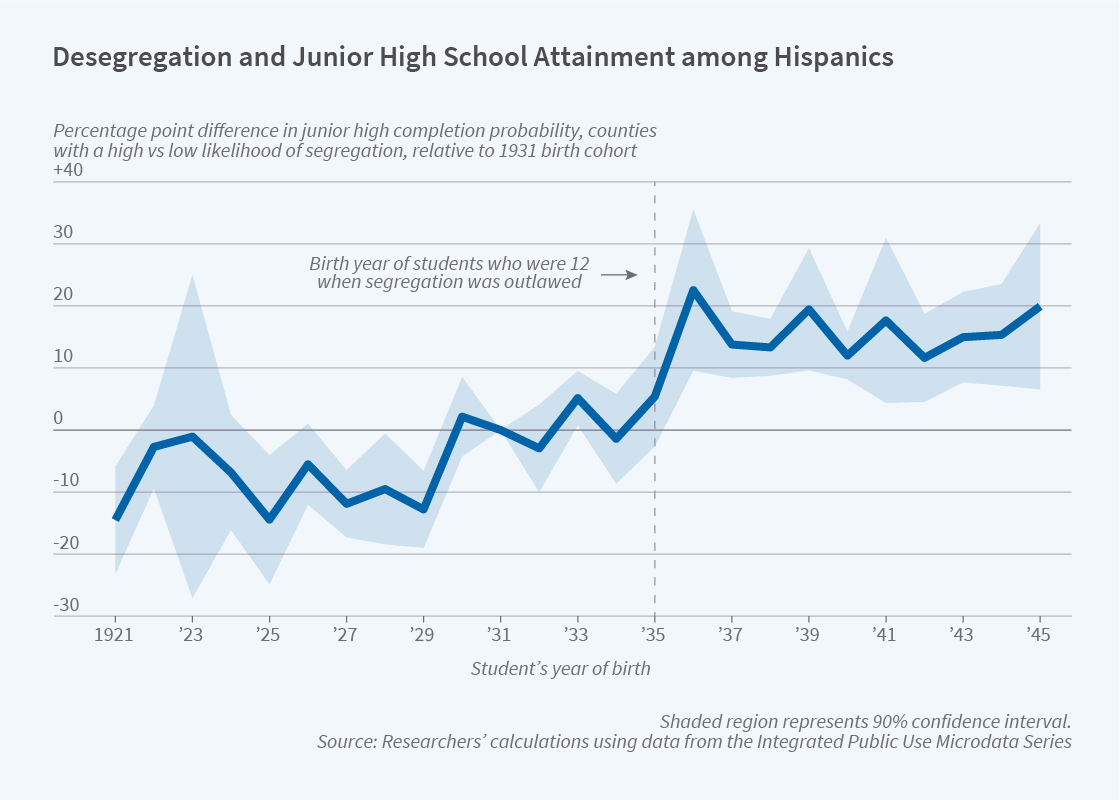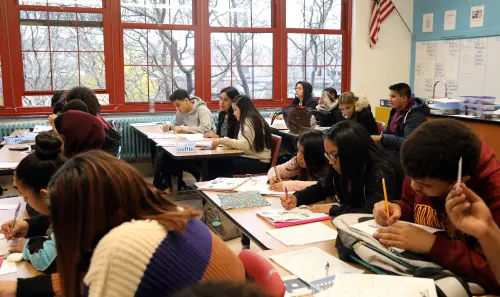A large body of research has examined the seminal Brown v. Board of Education ruling in 1954 and its implications for Black students in the United States. Less well-known is the 1947 Mendez v. Westminster decision, which ended de jure segregation of Mexican-Americans in California—a group that had long been segregated into separate schools and classrooms throughout the Southwest.
Understanding the impacts of the Mendez decision is critical to understanding the experience and present circumstances of the Latino/Hispanic community, which now makes up about one-fifth of the U.S. population and an even larger share of the U.S. public school population. A quantitative examination of the impacts of Mendez can also illuminate the potentially enormous benefits of integrating schools today, when Hispanic students remain among the most likely to be segregated.
MEXICAN-AMERICAN SEGREGATION IN CALIFORNIA SCHOOLS
The justification for segregating Mexicans and Mexican-Americans (regardless of citizenship) was largely rooted in racial discrimination. For example, proponents of segregation argued on the basis of cleanliness, intellectual ability, and English-language ability—despite the fact that Mexican-American children who did not speak Spanish were also segregated. While not always explicit, the underlying discriminatory motivation was clear in the larger effort to separate Mexicans and whites in public areas throughout the American Southwest.
In this context, Gonzalo Mendez and four other Mexican-American parents sued four Orange County, California, school districts on behalf of their children and 5,000 other children of “Mexican and Latin descent,” arguing that segregation violated their constitutional rights. Ultimately, an injunction was issued in federal district court against Mexican segregation on the grounds that it violated state law. The ruling was upheld by the 9th U.S. Circuit Court of Appeals in 1947. Since the school districts declined to appeal, the case never reached the U.S. Supreme Court. However, Mendez set an important precedent in the argument that the doctrine of “separate but equal” violated the equal protection clause of the 14th Amendment—an issue that would resurface a few years later in the Brown case.
ESTIMATING THE LONG-RUN IMPACTS OF DESEGREGATING SCHOOLS
We have been interested in uncovering impacts of this landmark decision. In a recently released study, we present the first quantitative analysis of the effects of the Mendez ruling on long-run educational attainment for Hispanics and non-Hispanic whites in California. Our focus on long-run impacts is important, since prior research indicates that the full effects of the Brown decision did not materialize until many years later. Similarly, we seek to understand whether the end of de jure Mexican segregation brought about by Mendez ultimately led to improvements in the opportunities available to Mexican-Americans.
One critical distinction between Mendez and Brown is the geographical setting. Studies looking at the desegregation of Black students frequently rely on data from the American South, where official data document enrollment for Black and white children in separate schools. In contrast, segregation policy in California was primarily decided at the local level, and official documentation of school segregation does not exist during the period of our study.
To get around this data limitation, we rely on the fact that historical sources suggest that segregation practices were closely linked with the share of Hispanics in the local population. Thus, our analytical strategy compares what happened in areas where Hispanics comprised a relatively large share of the local population (where segregation was more likely to occur) to what happened in areas with a smaller share of Hispanic residents. More specifically, within each of these types of areas, we compare outcomes for birth cohorts that started school before the Mendez ruling to birth cohorts that started school after the Mendez ruling. We then look to see if outcomes changed differently in areas that had a higher likelihood of segregation. If so, it seems likely that desegregation efforts after the Mendez decision affected student outcomes.
Our results indicate that the impact of school desegregation in 1947 was quite significant. We estimate an increase of almost 0.9 years of schooling for Hispanics in the cohorts that started school after Mendez relative to cohorts born 10 years prior. We find even larger effects, on the order of 1.9 years of schooling, if we compare treated cohorts with older birth cohorts that likely would have completed schooling prior to the Mendez ruling. This is quite a substantial increase given that the latter group only attained about 9.2 years of education on average.
This striking change over a relatively short period of time suggests that major milestones, such as junior high school and high school completion, may have also been affected. Thus, we assess the impacts of Mendez on those outcomes as well. An example appears in the figure below, which shows the impact of desegregation on junior high school attainment (at least eight years of completed schooling). On average, compared to birth cohorts that started school before Mendez, birth cohorts that started school after Mendez were 18.4% more likely to graduate from junior high school and 19.4% more likely to graduate from high school.
We do not have information on the pace of integration efforts, but to the extent that local desegregation policies evolved more slowly than the timing of the court ruling suggests, we would expect the magnitude of these estimates to be, if anything, understated. Overall, our findings indicate a substantial long-run educational benefit to Hispanic students stemming from desegregation.
As an extension, we also examine impacts on non-Hispanic whites and find evidence of a slight decline in educational attainment of non-Hispanic whites in birth cohorts that began school after Mendez in counties that were more likely to be segregated. Perhaps this could be explained by a shift toward a more equitable resource distribution following the end of de jure segregation.
Overall, these results indicate an important causal link between desegregation and greater equity across students of different backgrounds. This finding has historical importance, since it has been difficult—partly due to data limitations—to know the impact of the Mendez decision. Beyond that, however, we believe that these findings have implications for contemporary education policy. While the context differs today in many ways, Hispanic students remain among the most segregated student groups in the U.S., and many of the schools that they attend are badly under-resourced. A focus on desegregating schools and classrooms may be especially beneficial to closing the opportunity gaps experienced by many Hispanic students today.
The Brookings Institution is committed to quality, independence, and impact.
We are supported by a diverse array of funders. In line with our values and policies, each Brookings publication represents the sole views of its author(s).









